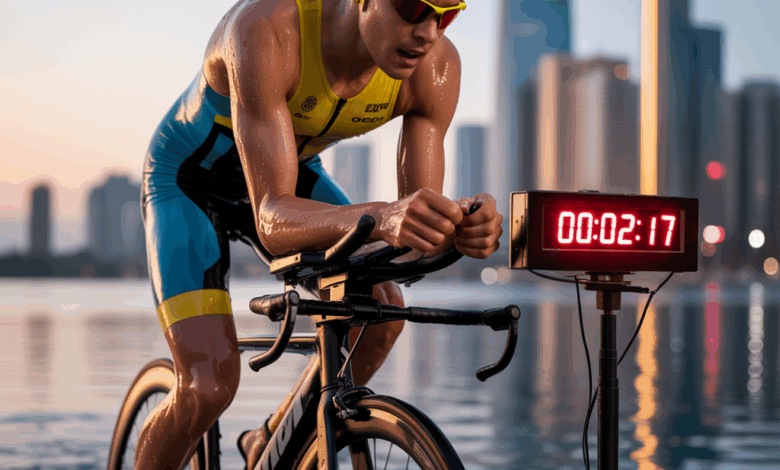How Long Does A Triathlon Take

Ever stood at the swim start, heartbeat racing, and wondered: how long does a triathlon take — and can I finish before sunset? Whether you’re picturing your first sprint tri or eyeing a full Ironman, understanding race durations, realistic finish times, and how training affects your race-day clock is the secret to smart preparation and less anxiety.
How long does a triathlon take? Average times by distance
Triathlon race duration varies wildly depending on the distance, course difficulty, weather, and your fitness level. Below are typical finish-time ranges for recreational athletes. These are averages — elite athletes are much faster, and beginners will likely be slower.
Sprint Triathlon (short)
- Distances: ~750m swim, 20km bike, 5km run
- Average finish: 1–2 hours
- Beginner range: 1.25–2.5 hours
Olympic / Standard Triathlon
- Distances: 1.5km swim, 40km bike, 10km run
- Average finish: 2–4 hours
- Recreational athlete range: 2.5–5 hours
Half-Ironman (70.3)
- Distances: 1.9km swim, 90km bike, 21.1km run
- Average finish: 4.5–8 hours
- Typical age-groupers: 5–7.5 hours
Ironman (full)
- Distances: 3.8km swim, 180km bike, 42.2km run
- Average finish: 9–17 hours
- Most recreational finishers: 10–15 hours
These ranges include transitions (T1 and T2) but not long breaks. Course type — flat vs. hilly — weather, and drafting rules also shift times. A windy bike course can add tens of minutes; open-water swims in heavy chop can add even more.
Factors that affect your triathlon time
Knowing what influences race duration lets you target training more effectively. Key variables include:
- Swim skill and open-water experience — sighting, currents, and waves slow many newcomers.
- Bike power and handling — sustained watts, climbing ability, and cornering speed matter.
- Run endurance and pacing — how well you run off the bike (brick workouts help).
- Transitions — fast T1/T2 practice saves minutes.
- Equipment — a proper bike fit, aerodynamic gear, and shoes can shave time.
- Race strategy and nutrition — fueling mistakes cost energy and minutes.
Training tips and workout variations to cut minutes
Small, consistent changes yield big improvements. Here are practical, actionable tips to improve your overall time.
Swim workouts
- Interval sets (e.g., 10x100m with rest) to build speed and pacing.
- Open-water sessions to practice sighting and mass starts.
- Technique drills (catch, rotation, kick) to improve efficiency.
Bike workouts
- Threshold rides (3–6 x 8 minutes at race pace) to raise sustained power.
- Hill repeats to improve climbing and leg strength.
- Long endurance rides with tempo sections to simulate race fatigue.
Run workouts
- Brick sessions: bike 60–90 minutes then run 20–40 minutes to adapt to bike-run transition.
- Speedwork: intervals and tempo runs to increase lactate threshold.
- Long runs weekly to build aerobic base for half and full distances.
Strength & mobility
- Full-body strength 2x/week: squats, deadlifts, single-leg work and core stability.
- Mobility routine for hips, shoulders, and thoracic spine to improve form and reduce injury risk.
For structured plans, check out our workout routines page for training templates tailored to sprint, Olympic, and Ironman distances.
Race-day strategy: pacing, nutrition, and transitions
Race-day mistakes cost more than just time — they can ruin the event. Here’s how to make the most of your preparation.
- Pacing: Start controlled on the swim and bike; avoid red-lining early. Use perceived effort and a bike computer if available.
- Nutrition: Practice race fueling in training. For long events, plan 200–300 kcal/hour on the bike and small, digestible snacks for the run.
- Transitions: Lay out gear efficiently, rehearse putting on helmet and shoes quickly, and practice racking/unracking your bike.
- Mindset: Break the race into segments; focus on the immediate task rather than total hours remaining.
For fueling and meal timing tips that support endurance training, visit our nutrition guides section.
Real-world examples: beginner to age-group athlete
Here are three snapshots to help you visualize how training level translates to finish times:
- Beginner Anna (first sprint): trains 6–8 hours/week, comfortable swimmer, casual cyclist — finishes a sprint in ~1.8 hours.
- Weekend warrior Ben (consistent training): trains 8–12 hours/week, good bike and run — completes an Olympic in ~3–3.5 hours.
- Age-grouper Claire (targeting podium): trains 12–18 hours/week, structured plan and strength work — half-Ironman in ~4.5–5.5 hours.
Individual goals vary — focus on steady progress rather than racing everyone else.
Healthy lifestyle habits that shorten race times
Your training is only part of the equation. Sleep, recovery, and daily habits accelerate gains:
- Sleep 7–9 hours/night to support recovery and performance.
- Hydrate consistently; low-level dehydration reduces power output.
- Periodize training to include easy weeks and deloads to prevent overtraining.
- Manage stress with mindfulness or short mobility sessions to keep training quality high.
For broader wellness ideas that complement your triathlon program, explore our wellness tips content.
Frequently Asked Questions
How long does it take to train for a triathlon?
Training time depends on distance and experience. For a sprint triathlon, many beginners can prepare in 8–12 weeks with 4–6 hours/week. Olympic distance often needs 12–20 weeks and 6–10 hours/week. Half and full Ironman require a longer build (up to 6–9 months) and more weekly volume.
How much time do transitions add to my overall race time?
Typical transition times range from 1–5 minutes for sprints and Olympics, and 5–15+ minutes for half/whole distance events (including gearing up, nutrition, and bathroom stops). Practicing transitions can shave several minutes off your total time.
How long does a triathlon take for beginners?
Beginners at sprint distance commonly finish between 1.25–2.5 hours. An inexperienced athlete attempting an Olympic will often finish in 3–5 hours. Beginner times vary widely based on swim comfort, bike skill, and run conditioning.
Conclusion — Take control of your time on race day
So, how long does a triathlon take? It depends — but with realistic expectations, structured training, proper nutrition, and smart race strategy, you can turn a scary unknown into a predictable, enjoyable achievement. Pick a distance, plan a progressive training cycle, practice transitions, and prioritize recovery. Ready to improve your finish time? Start with a plan and try one focused interval or brick workout this week.
Want help building a plan? Check our workout routines and nutrition guides, then sign up for updates to get weekly tips that move you closer to the finish line.





